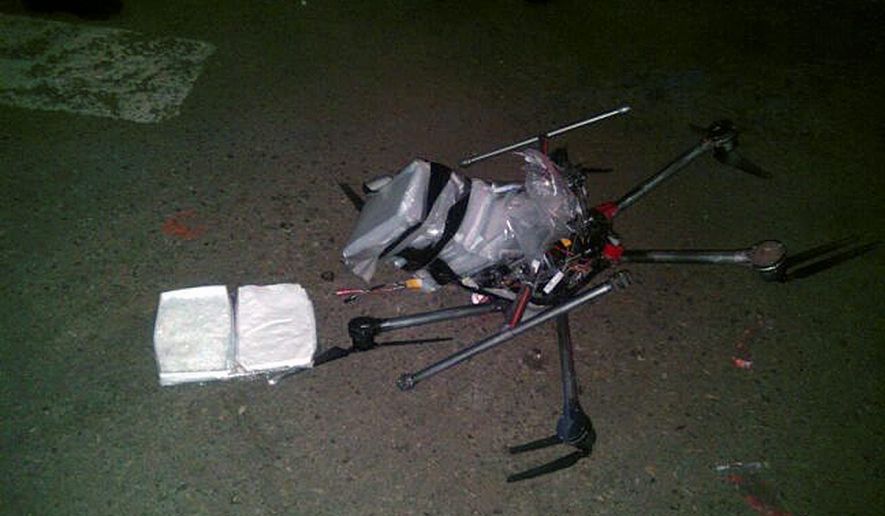The Border Patrol busted a 25-year-old man on drug-smuggling charges earlier this month after agents accused him of picking up a load of methamphetamine that smugglers flew over the border with a drone.
Agents said they saw the unmanned aerial vehicle (UAV) cross near San Diego and tracked it to its landing spot about 2,000 yards into the U.S., where Jorge Edwin Rivera, an American citizen, was waiting. They nabbed him and more than 13 pounds of meth, which they estimated to be worth $46,000 on the streets.
They also got the drone, giving them an important trifecta.
“At least in our sector, we’ve never gotten all three at once — the drone, the receiver and the narcotics,” said Christopher Harris, a Border Patrol agent and director of legislative and political affairs for Local 1613, the union for agents in the San Diego Sector.
Unmanned aerial vehicles have become one of the latest tools for drug cartels looking to get hard drugs from Mexico into the U.S. while avoiding more traditional routes of cars through ports of entry or tunnels underground.
While marijuana is still usually packed across because of its weight, hard drugs such as heroin, meth and cocaine are light enough that loads can be shot by catapult, carried by ultralight aircraft or flown over the border by UAV.
UAVs can also deliver drugs to pinpoint locations, allowing them to be sent directly into residential neighborhoods. In the Aug. 8 attempt, the drugs were flown to a neighborhood just on the edge of a border park.
Mr. Rivera admitted to the whole scheme, according to a probable cause statement filed in court laying out evidence against him.
He said he knew the drugs were being smuggled in from Mexico, and he was to be paid $1,000 for delivering the load, likely to a nearby Arco gas station, to someone he knew only as “Primo.”
He said he’d been making successful pickups each month since March, though agents suspect the number is higher.
Mr. Rivera also has previous smuggling convictions — once for carrying drugs across in a vehicle and another when he came through the port of entry with drugs taped to his thigh.
Agents spotted the drone as it came across the border and called it in. Then it became a matter of trying to guess where it would land.
One agent picked a neighborhood the Border Patrol calls Sales Trailers and hit the jackpot, finding the drone, Mr. Rivera and the drugs.
“Due to the agents’ heightened vigilance, this drone smuggling scheme was stopped before these dangerous narcotics could enter our communities,” said Acting Assistant Chief Patrol Agent Boone Smith.
Border security experts say drones present a challenge because they can drop drugs almost anywhere with little notice. There’s no telling how much drone traffic there actually is across the border.
And Customs and Border Protection has struggled to come up with rules of engagement for nontraditional aircraft. Ultralights — small, single-seat aircraft — were becoming common earlier this decade, prompting some border sheriffs to wonder why the U.S. didn’t shoot them down.
But knowing the origins of an aircraft isn’t easy, authorities said, and even then, firing into the sky is fraught with risk.
“Those are real challenges,” said one member of Congress who has tracked the issue.
Drones are an issue in areas where there are communities on both sides of the border, making drop-offs easy. Smugglers can program in GPS coordinates to make sure the drone ends up exactly where they want, Yuma County (Arizona) Sheriff Leon Wilmot told The Washington Times earlier this year.
Yuma has seen its own share of drone smuggling.
“There’s been a couple that’ve been intercepted, but most of the stuff they’re doing at night under cover of darkness,” the sheriff said, adding, “These aren’t cheap drones.”
The drone captured in the San Diego incident this month was a Matrice 600 Pro, which sells for about $5,000. The manufacturer says it can take off with a 13-pound load, and can fly at 40 miles per hour.
• Stephen Dinan can be reached at sdinan@washingtontimes.com.




Please read our comment policy before commenting.